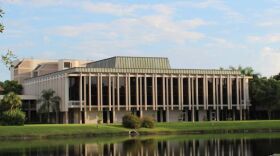Weather researchers and forecasters from NOAA were among the hurricane experts who traveled to Fort Myers to look for subtle clues left behind by Hurricane Ian that might help improve the forecast during future tropical cyclones.
Brian LaMarre, chief meteorologist at the National Weather Service in Tampa, was leading his colleagues from NOAA on the damage survey even though this isn’t where Ian made landfall. But San Carlos Island is where winds howled at nearly 150 miles per hour and storm surge reached 15 feet. The boats still up in the trees prove it.
“It is a worst-case scenario,” LaMarre said of the whole Fort Myers Beach region. “I think we at the National Weather Service would be failing in our jobs if we did not use this event as an opportunity to learn and also to capture how significant and how deadly the impacts have been in this area.”
The NWS team wasn’t examining the typical stuff, like how far inland a big boat was carried by the storm surge, or exactly how many mobile homes were destroyed.
They are looking for more precise, less obvious signs Ian left behind.
“We're not looking at the wave action on top of the surge,” he said. “We’re actually looking to see what is the still water level that has reached in businesses and people’s homes and that is going to help us fine tune the storm surge model in the future to provide even more accurate forecasts."
Activity picked up on San Carlos Island the day the NOAA team was there as it was the first day the media and others with a reason to be there were allowed through a checkpoint.
Trucks full of debris rumbled away one after the other. Residents collected what they had left into U-Hauls, then drove off the island toward somewhere better than where they were.
Pablo Santos spent some time earlier in the week examining Hurricane Ian’s devastation in Collier County, where onshore winds gusting to at least 140 miles per hour did a great share of damage as well, even if the storm surge was less.
“This is catastrophic where you're seeing here,” Santos said of San Carlos Island, which is the mainland inside Fort Myers Beach. “But I don't want to lessen the impact that they saw down in the Collier County because it was significant.”
Santos said Hurricane Ian was so big, and so strong, that even being a county away made very little difference.
“Of course, at the end of the day, when all is said and done, the amount of storm surge down south is less than it was was here,” he said. “You get four feet of water inside your house you're gonna lose all your belongings, right, and it's no difference to somebody who might experience eight feet inside. They are devastated nevertheless, right?”
LaMarre and Santos left with several observations in their minds that they think will help with better forecasts of the track, the timing, the intensity of hurricanes-to-come.
“In the future I think they'll definitely be improvement in the modeling for storm surge and the modeling of hurricane track forecasting,” LaMarre said. “And in intensity forecasting in general.”
Environmental reporting for WGCU is funded in part by VoLo Foundation, a non-profit with a mission to accelerate change and global impact by supporting science-based climate solutions, enhancing education, and improving health.
Sign up for WGCU's monthly environmental newsletter, the Green Flash, today.
WGCU is your trusted source for news and information in Southwest Florida. We are a nonprofit public service, and your support is more critical than ever. Keep public media strong and donate now. Thank you.








